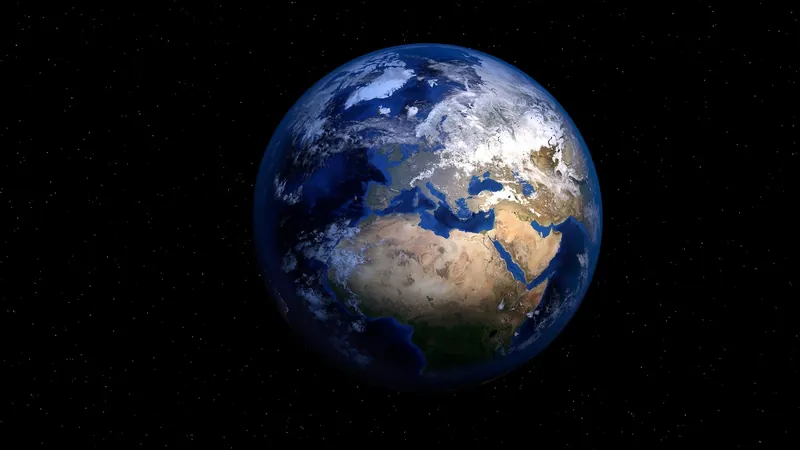
Unlocking Earth's Climate Secrets: How Scientists Explore Our Planet's Ancient Past
2025-01-10
Author: Mei
The Climate Archive: A Window to the Past
Paleoclimatologist Etienne Legrain, part of a dedicated team on a mission in Antarctica, explained, "To understand the past climate, we search for archives that have documented temperature changes." Among the richest sources are marine sediment cores and ice cores.
Marine sediment cores, which accumulate at the ocean’s floor, are replete with tiny organisms called foraminifera. These critters leave behind shells that crystallize the temperatures of their era, acting like pages from Earth's climate history. Meanwhile, ice cores, drilled deep within glaciers, hold frozen records of atmospheric conditions. "The deeper we descend, the farther back in time we can explore," Legrain commented after returning from a South Pole expedition.
Data Precision and Temperature Trends
Using these ancient records, scientists can construct a timeline that stretches back hundreds of thousands of years. Advanced techniques, such as analyzing the weight of ice molecules, allow researchers to infer the temperatures when the ice was formed. Legrain noted that despite limitations in precision, these multiple data sources often reveal correlated temperature trends. "This convergence gives us a robust level of confidence,” he stated.
According to the UN's climate panel, the global average temperature over the past decade is about 1.1 degrees Celsius higher than levels recorded between 1850 and 1900, surpassing conditions seen during previous warm periods. The recent Intergovernmental Panel on Climate Change (IPCC) report highlighted that today's climate may exceed temperatures from 6,500 years ago and is on a trajectory that might culminate in the highest temperatures in 800,000 years if greenhouse gas emissions continue at their current rate.
A Rapid Temperature Surge
The stark reality is that the world is heading towards nearly a 3-degree Celsius increase compared to the 19th century baseline—levels not witnessed for 2 to 3 million years. Back then, the planet operated with temperatures around 2 to 3 degrees warmer than pre-industrial times. The mechanisms behind past warming events involved gradual changes, such as Earth's axial tilt resulting in variations in solar energy receiving frequencies.
In contrast, today's temperatures have escalated almost one degree in merely 50 years, a rate approximately 40 times faster than during the Eemian interglacial period, where temperatures increased by about 1 degree every 2,000 years, providing more time for ecosystems to adapt.
Navigating Climate Complexity
Maria Sanchez Goni, a paleoclimatologist from France’s EPHE Institute, cautions against oversimplifying the climate reconstruction process, stating it can be challenging to establish average temperatures over vast regions or pinpoint them to specific years. A 2020 study attempted to utilize pollens, insects, and geochemical markers to analyze the last 12,000 years of climate. While intriguing, Goni noted the study could only provide rough estimates regarding global temperatures over the past 150 years, leaving the door open to the possibility that a distant year could have rivaled the warmth expected in 2024.
As our planet grapples with climate change, these scientific endeavors into Earth's ancient past are more critical than ever. They serve not only as records of historical climate patterns but also as warnings and guides for navigating our future. How well we heed their lessons may determine the fate of our planet in the decades to come. 🥵🌍


 Brasil (PT)
Brasil (PT)
 Canada (EN)
Canada (EN)
 Chile (ES)
Chile (ES)
 Česko (CS)
Česko (CS)
 대한민국 (KO)
대한민국 (KO)
 España (ES)
España (ES)
 France (FR)
France (FR)
 Hong Kong (EN)
Hong Kong (EN)
 Italia (IT)
Italia (IT)
 日本 (JA)
日本 (JA)
 Magyarország (HU)
Magyarország (HU)
 Norge (NO)
Norge (NO)
 Polska (PL)
Polska (PL)
 Schweiz (DE)
Schweiz (DE)
 Singapore (EN)
Singapore (EN)
 Sverige (SV)
Sverige (SV)
 Suomi (FI)
Suomi (FI)
 Türkiye (TR)
Türkiye (TR)
 الإمارات العربية المتحدة (AR)
الإمارات العربية المتحدة (AR)